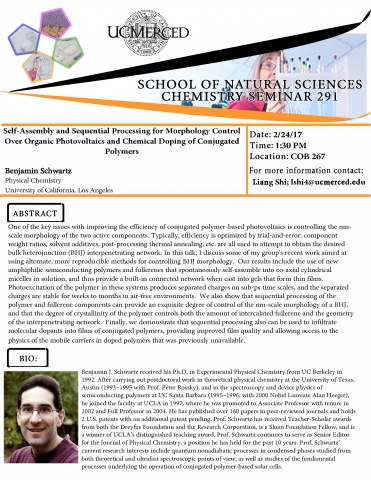Ben Schwartz, University of California, Los Angeles
Abstract:
One of the key issues with improving the efficiency of conjugated polymer-based photovoltaics is controlling the nm-scale morphology of the two active components. Typically, efficiency is optimized by trial-and-error: component weight ratios, solvent additives, post-processing thermal annealing, etc. are all used to attempt to obtain the desired bulk heterojunction (BHJ) interpenetrating network. In this talk, I discuss some of my group's recent work aimed at using alternate, more reproducible methods for controlling BHJ morphology. Our results include the use of new amphiphilic semiconducting polymers and fullerenes that spontaneously self-assemble into co-axial cylindrical micelles in solution, and thus provide a built-in connected network when cast into gels that form thin films. Photoexcitation of the polymer in these systems produces separated charges on sub-ps time scales, and the separated charges are stable for weeks to months in air-free environments. We also show that sequential processing of the polymer and fullerene components can provide an exquisite degree of control of the nm-scale morphology of a BHJ, and that the degree of crystallinity of the polymer controls both the amount of intercalated fullerene and the geometry of the interpenetrating network. Finally, we demonstrate that sequential processing also can be used to infiltrate molecular dopants into films of conjugated polymers, providing improved film quality and allowing access to the physics of the mobile carriers in doped polymers that was previously unavailable.




